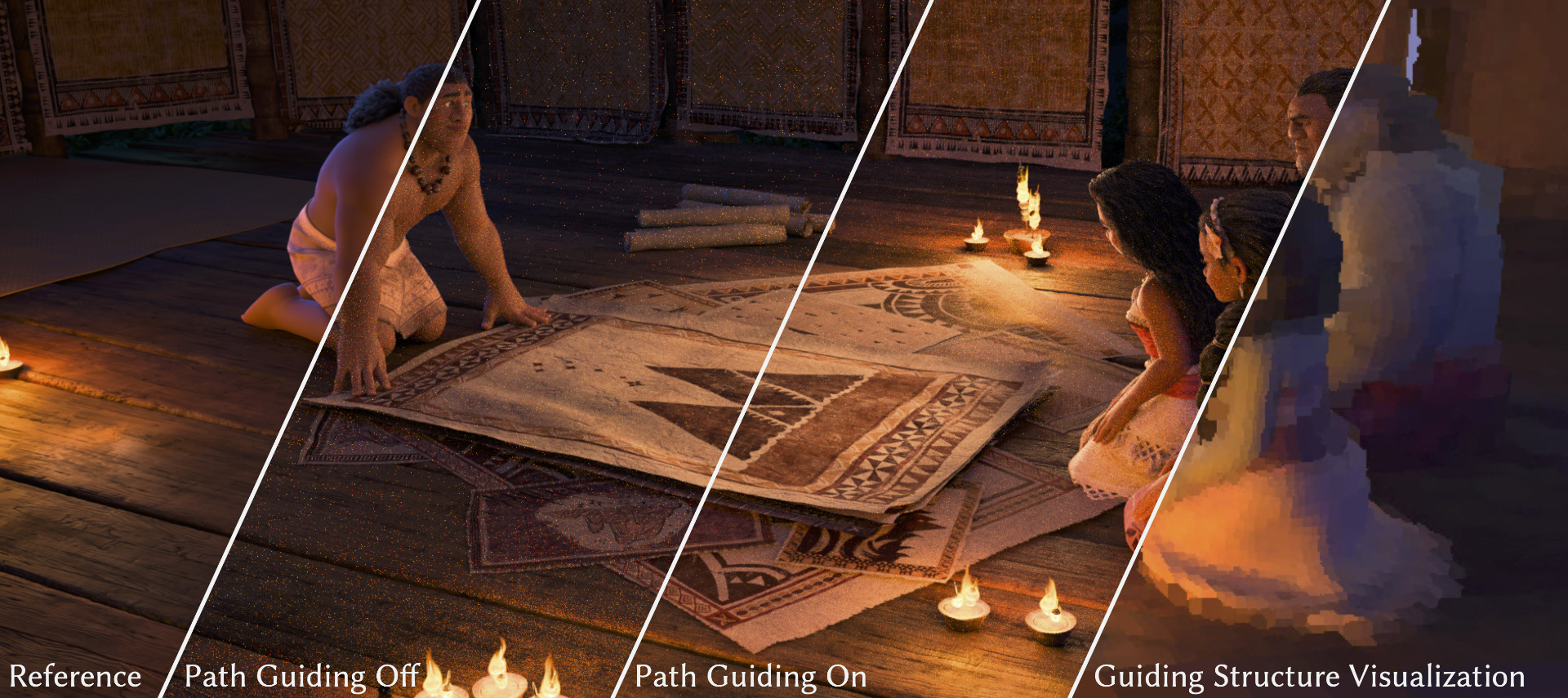Course Notes for "Path Guiding in Production and Recent Advancements", Pages 30-66.
ACM SIGGRAPH 2025 Courses. Article No. 14
We present our approach to implementing a second-generation path guiding system in Disney's Hyperion Renderer, which draws upon many lessons learned from our earlier first-generation path guiding system. We start by focusing on the technical challenges associated with implementing path guiding in a wavefront style path tracer and present our novel solutions to these challenges. We will then present some powerful visualization and debugging tools that we developed along the way to both help us validate our implementation's correctness and help us gain deeper insight into how path guiding performs in a complex production setting. Deploying path guiding in a complex production setting raises various interesting challenges that are not present in purely academic settings; we will explore what we learned from solving many of these challenges. Finally, we will look at some concrete production test results and discuss how these results inform our large scale deployment of path guiding in production. By providing a comprehensive review of what it took for us to achieve this deployment on a large scale in our production environment, we hope that we can provide useful lessons and inspiration for anyone else looking to similarly deploy path guiding in production, and also provide motivation for interesting future research directions.
Part of the SIGGRAPH 2025 Course "Path Guiding in Production and Recent Advancements", presented by Sebastian Herholz (Intel), Lea Reichardt (Walt Disney Animation Studios), Marco Manzi (Disney Research|Studios), and Martin Šik (Chaos).
Course Abstract (Author's Version), PDF (1.7 MB)
Full Course Notes (Author's Version), PDF (226.6 MB)
Standalone Disney Animation Course Notes Chapter (Author's Version), PDF (79.9 MB)
Official Course Website (External Link)
Lea Reichardt, Brian Green, Yining Karl Li, and Marco Manzi. Path Guiding Surfaces and Volumes in Disney's Hyperion Renderer: A Case Study. Path Guiding in Production and Recent Advancements, ACM SIGGRAPH 2025 Course Notes. Aug 2025.
@article{Reichardt2025HyperionPathGuiding,
author = {Reichardt, Lea and Green, Brian and Li, Yining Karl and Manzi, Marco},
title = {Path Guiding Surfaces and Volumes in Disney's Hyperion Renderer: A Case Study},
journal = {Path Guiding in Production and Recent Advancements, ACM SIGGRAPH 2025 Course Notes},
month = aug,
year = {2025},
articleno = {14},
pages = {30-66},
doi = {10.1145/3721241.3733994}
}
We thank our partners at DisneyResearch|Studios for their work on this project; specifically, we thank Alexander Rath, Lento Manickathan, Marios Papas, and Tiziano Portenier for their contributions. We are also grateful to Sebastian Herholz from Intel for his assistance with OpenPGL, and to Wei-Feng Wayne Huang for authoring the original project proposal that precipitated this entire effort. We also thank our partners from production who helped us conduct tests on active production data during several previous shows; in particular, we thank Alex Nijmeh, Bernie Wong, Diana LeVangie, Kendall Litaker, Kenji Endo, Laura Grondahl, Mohit Kallianpur, and Sujil Sukumaran. We also thank Brent Burley, Daniel Teece, Mackenzie Thompson, Charlotte Zhu, Sergio Sancho and Xianyao Zhang for their detailed feedback on and suggestions for these course notes. Finally, we are indebted to the rest of the Hyperion development team and to Disney Animation and DisneyResearch|Studios' tech leadership and managers for their support for this project.
© The Author(s) / ACM. This is the author's version of the work. It is posted here for your personal use. Not for redistribution. The Definitive Version of Record is available at doi.acm.org.
